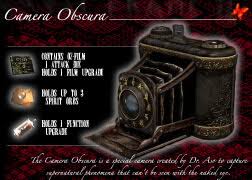
Camera Obscura Fatal Frame
The early camera that first became a phenomenon was a little more than a pinhole camera and can be traced back to 1558. It was called the Camera Obscura. The Camera Obscura was seen as a drawing tool for a clearer and realistic portrayal of objects. It was in the early 19th century that an invention named the Camera Lucida was introduced by Cambridge scientist William Hyde Wollaston that consisted of an optical device that could help an artist view a distant scene or person or object on a paper surface that he or she was using to draw. In other words the artist gets to view a superimposed image of a subject on paper and this image could be effectively used to attempt to draw, trace or paint it. Both the Camera Obscura and the Camera Lucida provided an image that was temporary, which could not be lastingly captured on to paper for later reference.

One popular, early ancestor of today's picture-snappers were called camera obscuras. They did not function in the way we think of cameras; instead, they were more like projectors. In ancient times, camera obscuras were only able to project upside-down, yet proportionate, in color, and in perspective. The first camera obscura was designed by Alhazen, and was actually called a pinhole camera at first. In the 18th century, people figured out how to turn the image right side up using mirrors.






Camera Obscura Fatal Frame

0 comments:
Post a Comment
Hi, please feel free to share your comment here.
For example: Which pictures is the best?
Thanks,
Admin